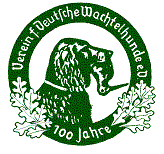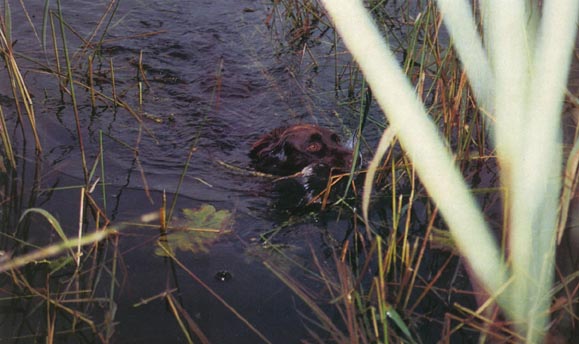The Wachtelhunde
by Bruce Ranta

|
Color is not a concern but the quality of the fur is. The coat of the wachtel consists of two layers with the outer layer being long and straight or somewhat wavy, but not curly, except around the neck and on the outside of the ears. The undercoat should be short and thick. Because the wachtel is a working dog, it's recommended that the tail be bobbed. For the winter, it's also suggested the long hair between the toes be sheared because ice tends to build up there. Not all of Gerhard's wachtels have bobbed tails, and this does not seem to be a problem. In fact, the dog uses its strong tail like a rudder when swimming. In Germany, the wachtel breeders association is called Verein fair Deutsche Wachtelhunde (VDW). The VDW is a member of the German Dog Breeding Association (VDH) which in turn is a member of the Federation Cynologique International (FCI), a worldwide dog breeders' association. Under this system, about 6,000 wachtels are registered in Germany. About the same number are registered outside Germany, most of them in Fennoscandia and Europe. In North America they are virtually absent and are still not registered with either the American or Canadian Kennel Clubs. In Europe, a wachtelhunde must meet many criteria before permission is granted to breed. First, both dogs must be registered with the VDW or another registry recognized by the FCI. They must also have a conformity judge classify them as "good" or better. X-rays must show the dogs to be free of any visible hip dysplasia and they must have participated in and done well in a breeding trial. Breeding trials are done when the dogs are young, up to the age of 15 months. This is designed to ensure the natural, innate and inbred qualities of the breed exists in the dog one eventually hopes to propagate. In breeding trials, the wachtels have to demonstrate nose-work, baying while on the track of a hare, and flushing capability in thickets and in marshland. As all wachtels are bred specifically for hunting, most breeders also have their dogs tested in field trials. European field trials are serious business, the big showcase where the owner can show off his or her skills as a trainer as well as the natural skills of their prize dogs. As my friendship with Gary grew, along with my admiration of his wachtels, I toyed with the possibility of having a wachtel of my own. Finally, with some prodding from Gary, Lil and I decided to take the plunge and told Gerhard that we would be more than happy to have one of the pups the next time he bred Ilka. We chose a dark brown female. When the pup was eight weeks old, Lil zipped up the furry little creature inside her snowmobile suit one frigid evening in early January, and we took off across the frozen river to the truck and home (Gary has no road access to his hunting lodge home). There was nary a peep from little Heidi.
|
|
For more information or to find a Wachtelhund to purchase, visit wachtelhund.com or contact: John Oberhaus joseph9970@fbcom.net 563-210-8273 |

